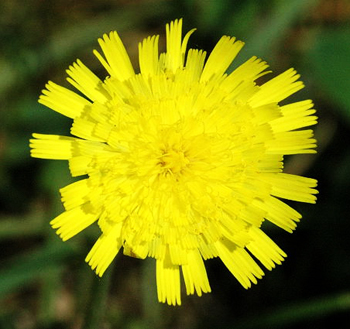Contents:
Common Names | Parts Usually Used | Plant(s) & Culture | Where Found | Medicinal Properties
Legends, Myths and Stories | Uses | Formulas or Dosages | Bibliography
Scientific Names

- Hieracium pilosella L.
- Compositae
- Composite family
Common Names
- Felon herb
- Hawkweed
- Meadow Hawkweed
- Mouse bloodwort
- Pilosella
Parts Usually Used
The entire plant
Back to Top

Description of Plant(s) and Culture
Mouse ear is a small perennial plant; creeping, leafy runners propagate the plant so that it forms dense, weedy patches. The bristly, spatulate leaves, forming a basal rosette, are green on top and downy-white beneath. Solitary, although sometimes 2-4, yellow flowerheads rise from 4-15 inches above the ground on bristly scapes and are subtended by hairy, pointed bracts. Flowering time is from May to September. Culpeper says that this herb stays green all winter.
There is a plant called Virginia Mouse-ear (Cynoglossum morrisoni) that is a related annual plant similar in appearance to hound’s tongue but with white or light blue flowers. The root is an effective astringent.
Back to Top
Where Found
Grows in dry soil on lawns, fields, pastures, hilly areas, and waste places from Ontario south to New York and Pennsylvania, and west to Michigan and Ohio.
Back to Top
Medicinal Properties
Astringent, cholagogue, diuretic
Back to Top
Legends, Myths and Stories
Gnaphalium uliginosum is called also mouse ear.
H. pilosella is said to be so powerful as to harden iron or steel; that if any edge or pointed tool is often quenched in the juice of this herb, it will cut all other iron, steel or stone very easily without turning the edge or point. Alchemists recommended the juice to congeal mercury, but all these fancies are not accepted today, of course. Also, the claim that if this herb is given to a horse, the shoeing of the horse will not cause the horse pain.
Back to Top
Uses
Mouse Ear is used for diarrhea and a gargle for throat problems. As a powder, sniff it into the nose to stop the nosebleed. A decoction of Mouse Ear used for liver and spleen problems, dropsy, jaundice, blood purifier, cankers, ulcers, sores, and bladder stones. Taken over a long period of time, it is reputed to help cataracts, but this claim has been disputed. Externally, helps heal wounds.
Back to Top
Formulas or Dosages
Gather the flowering plant.
Infusion: steep 1 to 2 tsp. in 1 cup boiling water. Take 1 cup per day.
Decoction: boil 1 to 2 tsp. of the herb in 1 cup water until 1/2 cup liquid remains. Take 1/2 cup per day.
Back to Top
Bibliography
![]() American Folk Medicine
American Folk Medicine, by Clarence Meyer, Meyerbooks, publisher, PO Box 427, Glenwood, Illinois 60425, 1973
![]() The Complete Medicinal Herbal
The Complete Medicinal Herbal, by Penelope Ody, Dorling Kindersley, Inc, 232 Madison Avenue, New York, NY 10016, First American Edition, copyright 1993
![]() Culpeper’s Complete Herbal & English Physician: Updated With 117 Modern Herbs
Culpeper’s Complete Herbal & English Physician: Updated With 117 Modern Herbs, by Nicholas Culpeper, Meyerbooks, publisher, PO Box 427, Glenwood, Illinois 60425, 1990, (reprint of 1814)
![]() The Herbalist Almanac
The Herbalist Almanac, by Clarence Meyer, Meyerbooks, publisher, PO Box 427, Glenwood, Illinois 60425, copyright 1988, fifth printing, 1994
![]() The Herb Book
The Herb Book, by John Lust, Bantam Books, 666 Fifth Avenue, New York, NY. copyright 1974.
![]() Webster’s New World Dictionary
Webster’s New World Dictionary, Third College Edition, Victoria Neufeldt, Editor in Chief, New World Dictionaries: A Division of Simon & Schuster, Inc., 15 Columbus Circle, New York, NY 10023
